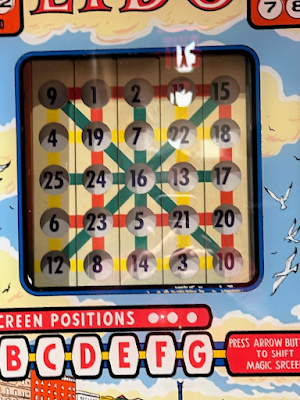Roanoke, a town of 320,000 is filled with outstanding museums (way above average for its size), great restaurants, and a beautiful setting of rolling hills set in a hardwood forest. We just kept finding wonderful things to do and places to see right up to the last day.
Our last day was spent playing pinball because.... Roanoke has a Pinball Museum. For my youthful readers, 'pinball' was what people played prior to video games. Thanks to the Covid Pandemic, pinball has made a big comeback. Apparently, spending a whole bunch of time at home meant, if you were a man, then you needed a 'man cave' equipped with your own pinball machine. I actually talked to two 30ish nerdy guys who were debating the best of the newest machines.
Here's what one of the newest of the new pinball machines looks like: It's called "Weird Al's Natural Museum of Hilarity" and has the most up to date solid state innards and a pixel based monitor. It also leaves a lot to be desired in terms of reliability. It broke multiple times in the first three months of its arrival at the Pinball Museum. I played it. More about that later.

Of much more interest was my talk with "Jason", a mechanical engineer, who volunteers his time repairing these machines. When I first saw him, he was changing out a transistor based innard for a mother board in a game manufactured prior to 1977. That was a pivotal year for pinball: Electronic motherboards appeared and took the place of 'wires' and transistors. Here's what a transistor innard looks like in an old pinball machine. Jason was changing out these innards and transforming the game into a motherboard/solid state game. As the older machines age, parts are just not available. He will use the same 'top', but the mechanics inside will be completely different.
Wires and Transistors - how every pre-1977 pinball machines looked inside. (above and below left). The conversion to motherboards - pre1977 to post-1977 pinball machines (below right)
Whenever I talk to someone who really enjoys either his job or his hobby, there's such enthusiasm. Jason couldn't wait to show me the 'special' machines. First up, is 'Humpty
Dumpty'. This game was designed in 1947 and it is the first game to employ 'flippers'. However, they are NOT in the place you would normally expect. See is you can find them:
Yes, that's the flippers: Right above the 10,000 yellow barrels which is about half way up the machine. It's not until later, that flippers descend closer to the bottom of the machine. And, it's not until the introduction of the solid state machines that flippers got bigger.
Drake is an old time pinball player since he played a machine at the pool hall in Altus, Oklahoma during his last two years of high school. His favorite machine at the museum was a Bally machine called Bows and Arrows. He said this one has the features he was most accustomed to from that era. It also has the small flippers and mechanical counters to keep track of your score.
Another strange machine from the 1950's was one called "Lido". It seemed to blend a gambling element, almost like a slot machine. You could choose your 'level' to play depending on how many nickels you initially fed into the machine. I think the photographs will help you get the picture.
I really wanted to play this machine, but it was one 'under repair'. Jason told me it was almost impossible to have all the 'old' machines up and running all the time. I decided to skip up to some of the first motherboard machines. I noticed two things about the more modern machines: (1) The flippers were about 1/3rd bigger, and (2) the machine would hide the ball, and you had to be prepared for the ball to squirt out in various places. Initially, I would just stand there as the ball shot out about halfway down the board. I gradually got better - about a C- worth of better. Here's the machine I really liked which was one of the first to have an interactive monitor - the 'bride' would have different faces depending on your score with each ball. At first, I didn't even realize what was happening. Here's what it looks like - very futuristic, very silver (instead of red, blue, yellow and green).
Remember, I said I'd played the 'newest' game? It shared more characteristics with the Bride of Pinbot than the Bow and Arrow Game. Here's a look at the 'board'. The ball, initially hidden from the player, would squirt out from multiple places. You had to be quick, quick, quick with the flippers.
The Pinball Museum is in the center of downtown. It's in the Market Square which has been selling stuff continuously since 1882, just as the railroad arrived, thanks to that $10,000 bribe.
The Center in the 21st century is home to a farmer's market, two museums, a few stores (like a candy store!), the local stage for live theater, and a miniature aquarium. Here's my favorite aquarium shot.
We waved goodbye to Roanoke, and hit the road for Asheville. It's in the mountains, and if the Canadian smoke ever clears, this place nestled up against the Great Smokey Mountain National Park should be lovely. I'm already getting the vibe that Asheville is to North Carolina as Austin is to Texas.
Here are more pinball pictures. I'm playing a Beatles pinball game.
















